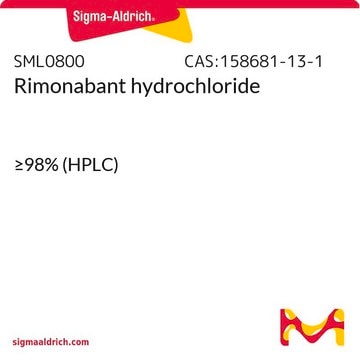This product is intended for research use only and is not to be used for unauthorized commercial uses, in vitro diagnostic uses, ex vivo or in vivo therapeutic uses, or any type of consumption or application to humans or animals. This product is soluble in DMSO and insoluble in water. Stability once in solution has not been tested in-house. Other sources do not recommend storing the aqueous solution for more than one day.
A9719
Arachidonyl-2′-chloroethylamide hydrate
≥97% (HPLC), oil
Synonyme(s) :
ACEA
Sélectionner une taille de conditionnement
377,00 €
Sélectionner une taille de conditionnement
About This Item
377,00 €
Produits recommandés
Niveau de qualité
Essai
≥97% (HPLC)
Forme
oil
Contrôle du médicament
regulated under CDSA - not available from Sigma-Aldrich Canada
Conditions de stockage
desiccated
Couleur
brown-red
Solubilité
DMSO: soluble
H2O: insoluble
Température de stockage
−20°C
Chaîne SMILES
CCCCC\C=C/C\C=C/C\C=C/C\C=C/CCCC(=O)NCCCl
InChI
1S/C22H36ClNO/c1-2-3-4-5-6-7-8-9-10-11-12-13-14-15-16-17-18-19-22(25)24-21-20-23/h6-7,9-10,12-13,15-16H,2-5,8,11,14,17-21H2,1H3,(H,24,25)/b7-6-,10-9-,13-12-,16-15-
Clé InChI
SCJNCDSAIRBRIA-DOFZRALJSA-N
Informations sur le gène
mouse ... Cnr1(12801) , Cnr2(12802)
rat ... Cnr1(25248)
Actions biochimiques/physiologiques
Caractéristiques et avantages
Attention
Code de la classe de stockage
10 - Combustible liquids
Classe de danger pour l'eau (WGK)
WGK 3
Point d'éclair (°F)
Not applicable
Point d'éclair (°C)
Not applicable
Équipement de protection individuelle
Eyeshields, Gloves, multi-purpose combination respirator cartridge (US)
Faites votre choix parmi les versions les plus récentes :
Certificats d'analyse (COA)
Vous ne trouvez pas la bonne version ?
Si vous avez besoin d'une version particulière, vous pouvez rechercher un certificat spécifique par le numéro de lot.
Déjà en possession de ce produit ?
Retrouvez la documentation relative aux produits que vous avez récemment achetés dans la Bibliothèque de documents.
Les clients ont également consulté
-
Can the medicine be dissolved in deionized water or DMSO? How many months can the solution be stored after dissolution? What should be the storage conditions in degrees Celsius?
1 answer-
Helpful?
-
Active Filters
Notre équipe de scientifiques dispose d'une expérience dans tous les secteurs de la recherche, notamment en sciences de la vie, science des matériaux, synthèse chimique, chromatographie, analyse et dans de nombreux autres domaines..
Contacter notre Service technique











